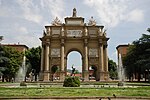Stibbert Museum
Art museums and galleries in FlorenceMilitary and war museums in ItalyMuseums in Florence

The Stibbert Museum (Italian: Museo Stibbert) is located on via Frederick Stibbert on the hill of Montughi in Florence, Italy. The museum contains over 36,000 artifacts, including a vast collection of armour from Eastern and Western civilizations.
Excerpt from the Wikipedia article Stibbert Museum (License: CC BY-SA 3.0, Authors, Images).Stibbert Museum
Via di Montughi, Florence Quartiere 5
Geographical coordinates (GPS) Address Nearby Places Show on map
Geographical coordinates (GPS)
| Latitude | Longitude |
|---|---|
| N 43.792883333333 ° | E 11.255175 ° |
Address
Villa Stibbert
Via di Montughi
50139 Florence, Quartiere 5
Tuscany, Italy
Open on Google Maps









